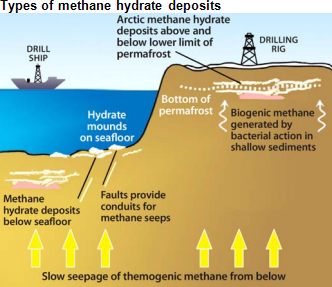Japan announced Tuesday that researchers had succesfully produced natural gas from offshore methane hydrates, a breakthrough with potentially explosive consequences for both global energy markets and the effort to tackle climate change.
The Japanese Ministry of Economy Trade and Industry announced that a team aboard a drilling ship pearched above the Eastern Nankai Trough had extracted the gas from hydrates trapped 1,000 feet below the sea floor surface. Methane hydrates, also known as clathrates, are deposits of natural gas trapped within the crystaline structure of frozen water, leading some to refer to hydrates as "fire ice."
 The extraction of usable gas from undersea methane hydrates Tuesday was thought to be the world's first, a breakthrough step towards tapping a potentially massive new alternative source of natural gas.Â
The extraction of usable gas from undersea methane hydrates Tuesday was thought to be the world's first, a breakthrough step towards tapping a potentially massive new alternative source of natural gas.Â
Estimates of the scale of hydrate resources are enormous, ranging from 10,000 trillion cubic feet (TCF) to more than 100,000 TCF. To put that into context, methane hydrates may contain anywhere from 50% more to 15 times more natural gas than all global shale gas deposits combined.
Of course, just as with shale gas, not all of this potential energy resource will prove technically recoverable. Yet if (or should we say when?) technology to commercially extract gas from hydrates is developed, the implications for global energy markets are staggering nonetheless.
"The commercialization of methane hydrate would result in a new natural gas revolution, even larger than the so-called shale gas revolution now underway," said Christopher Knittel, a professor of energy economics at the Massachussets Institute of Technology, in an email statement to TheEnergyCollective.com.
Hydrates could remake energy markets
Methane hydrates are the world's largest source of untapped fossil energy. And they are widely distributed across the world, as indicated in the graphic from the US Geological Survey (USGS) below.
"Methane hydrates are in large supply almost everywhere, trapped in the ocean floor off much of the world's coasts," says Knittel. "This means locations that either don't have large shale resources, or are reluctant to exploit them, can increase natural gas consumption without importing liquefied natural gas (LNG)."Â
A rough estimate by Japan's National Institute of Advanced Industrial Science and Technology pegs the total amount of methane hydrate in the waters surrounding Japan at more than 247 TCF, or enough gas to supply nearly a century's worth of Japan’s needs.
"Depending on where the final cost of capturing methane hydrates ultimately rests, this can mean large reductions in natural gas prices throughout the world," explains Knittel.Â
In short, methane hydrates could once again reshape global gas markets, just as the development of shale gas has done in the last decade.
"Game over" for the climate?
It's easy to see why he'd be concerned: methane hydrates contain more carbon than all the world's other fossil resources combined, according to USGS estimates.
If developed at a significant scale, hydrates would certainly be more than enough to cook the climate.Â
Depending on how cost-effective production of gas hydrates proves, this vast new fossil energy resource could lower energy prices worldwide. "These lower prices almost certainly will lead to an increase in fossil-fuel consumption on an energy basis," says Knittel. "That's the bad news, from a climate perspective."
To preseve any climate benefits of this hypothetical coal-to-gas shift, hydrate drillers would also have to be wary of letting methane leak out of hydrate deposits and into the atmosphere. Methane is an extremely potent greenhouse gas, and even modest leakage rates could nix any potential climate benefit of burning gas from hydrates instead of coal.
At this point, it is not clear how drillers would extract gas from hydrates without disturbing the deposits and causing methane to leak to the surface, or what the net impact on the environment might be. Those questions will have to be the subject of new research, which should be seen as an imperative as Japan and other nations explore gas production from hydrates.
"As with hydraulic fracturing, the commercialization of methane hydrates can lead to large reductions in greenhouse gases or large, catastrophic, increases," Knittel told me, "Which path we take will hinge on how policy makers respond."
Still a ways from commerical development
Despite this week's unprecedented step forward in producing gas from undersea hydrates, there's still much work to be done to develop a commercially profitable set of technologies for methane hydrate extraction. Yet the effort to develop technologies for hydrate extraction appears to be accelerating.
Yet yielding commercial quantities of natural gas from hydrates at an affordable price presents numerous challenges. Those challenges stem in part from the difficult environments in which hydrates are found and where would-be hydrate producers must drill: the frozen expanses of the Arctic and the deepsea abyss.
While further development is needed before hydrates yield commerical natural gas production, Japanese officials are betting that these challenges will be conquered soon.
Further Reading:
No comments:
Post a Comment